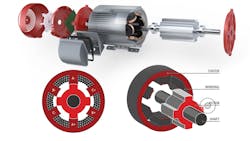New Motor Designs Help EV Makers Kick the Rare-Earth Habit (Part 2) (Download)
Electric vehicles (EVs) are still in their infancy with several "teething problems" that must be overcome before they can deliver on their potential to cut U.S. carbon emissions by as much as 24%.1 Among the most immediate issues is making EVs more affordable by developing motors that can be manufactured without any so-called rare-earth minerals. These include neodymium, terbium, and dysprosium used in the permanent-magnet synchronous motors (PMSMs) found in roughly 90% of the EVs on the road today.2
In Part 1 of this series, we explored several different types of wound-rotor synchronous motors (WRSMs) that replace the PMSM's permanent magnets with electromagnets. This installment will focus on switched reluctance motors (SRMs), one of the most common types of what’s referred to as induction machines. The concluding installment will explore synchronous reluctance motors (SynRMs), another promising sub-species of induction-type machines.
